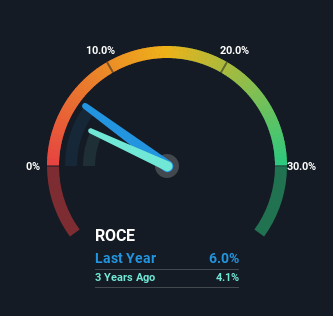There Are Reasons To Feel Uneasy About Force Motors' (NSE:FORCEMOT) Returns On Capital

To find a multi-bagger stock, what are the underlying trends we should look for in a business? Typically, we'll want to notice a trend of growing return on capital employed (ROCE) and alongside that, an expanding base of capital employed. If you see this, it typically means it's a company with a great business model and plenty of profitable reinvestment opportunities. In light of that, when we looked at Force Motors (NSE:FORCEMOT) and its ROCE trend, we weren't exactly thrilled.
Return On Capital Employed (ROCE): What Is It?
For those who don't know, ROCE is a measure of a company's yearly pre-tax profit (its return), relative to the capital employed in the business. The formula for this calculation on Force Motors is:
Return on Capital Employed = Earnings Before Interest and Tax (EBIT) ÷ (Total Assets - Current Liabilities)
0.06 = ₹1.5b ÷ (₹40b - ₹15b) (Based on the trailing twelve months to March 2023).
Therefore, Force Motors has an ROCE of 6.0%. In absolute terms, that's a low return and it also under-performs the Machinery industry average of 16%.
Check out our latest analysis for Force Motors

While the past is not representative of the future, it can be helpful to know how a company has performed historically, which is why we have this chart above. If you're interested in investigating Force Motors' past further, check out this free graph of past earnings, revenue and cash flow.
What Can We Tell From Force Motors' ROCE Trend?
When we looked at the ROCE trend at Force Motors, we didn't gain much confidence. Over the last five years, returns on capital have decreased to 6.0% from 9.2% five years ago. However, given capital employed and revenue have both increased it appears that the business is currently pursuing growth, at the consequence of short term returns. If these investments prove successful, this can bode very well for long term stock performance.
On a side note, Force Motors' current liabilities have increased over the last five years to 38% of total assets, effectively distorting the ROCE to some degree. Without this increase, it's likely that ROCE would be even lower than 6.0%. While the ratio isn't currently too high, it's worth keeping an eye on this because if it gets particularly high, the business could then face some new elements of risk.
The Bottom Line
Even though returns on capital have fallen in the short term, we find it promising that revenue and capital employed have both increased for Force Motors. And the stock has followed suit returning a meaningful 98% to shareholders over the last three years. So should these growth trends continue, we'd be optimistic on the stock going forward.
Force Motors does come with some risks though, we found 4 warning signs in our investment analysis, and 2 of those make us uncomfortable...
For those who like to invest in solid companies, check out this free list of companies with solid balance sheets and high returns on equity.
New: AI Stock Screener & Alerts
Our new AI Stock Screener scans the market every day to uncover opportunities.
• Dividend Powerhouses (3%+ Yield)
• Undervalued Small Caps with Insider Buying
• High growth Tech and AI Companies
Or build your own from over 50 metrics.
Have feedback on this article? Concerned about the content? Get in touch with us directly. Alternatively, email editorial-team (at) simplywallst.com.
This article by Simply Wall St is general in nature. We provide commentary based on historical data and analyst forecasts only using an unbiased methodology and our articles are not intended to be financial advice. It does not constitute a recommendation to buy or sell any stock, and does not take account of your objectives, or your financial situation. We aim to bring you long-term focused analysis driven by fundamental data. Note that our analysis may not factor in the latest price-sensitive company announcements or qualitative material. Simply Wall St has no position in any stocks mentioned.
About NSEI:FORCEMOT
Force Motors
An integrated automobile company, designs, develops, manufactures, and sells a range of automotive components, aggregates, and vehicles in India.
Flawless balance sheet with solid track record and pays a dividend.
Similar Companies
Market Insights
Community Narratives



